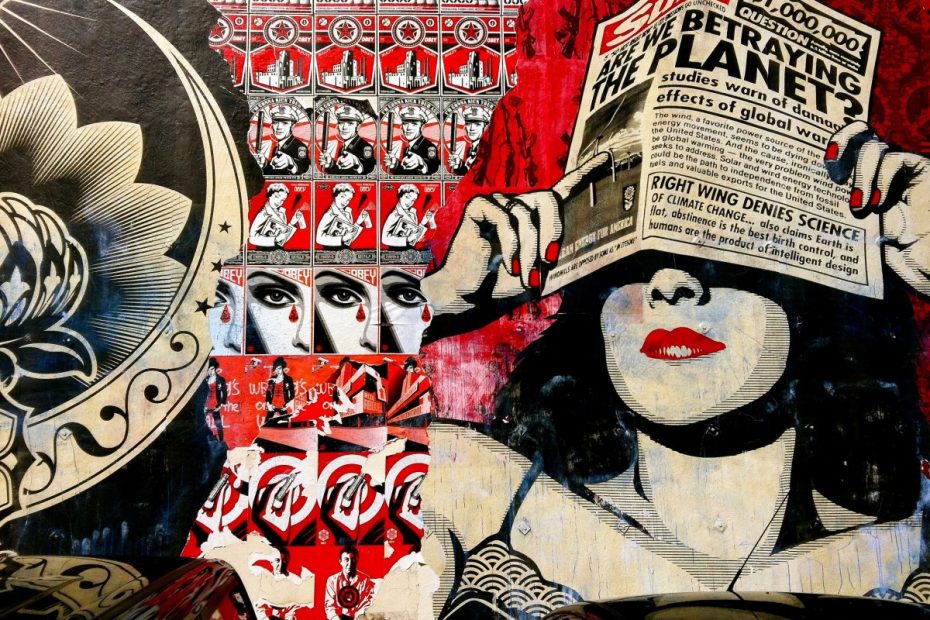Since the first election of Donald Trump, there’s been a pervading sense that America has lost its grip on reality. At this point, we’ve all heard some version of it: Post-reality politics. The post-truth era. Gaslighting. The iconic, Fake News.
It’s as if we all woke up one day to realize that Americans no longer shared a baseline of facts, let alone values. Who could forget during the first Trump term when Kellyanne Conway dropped the all-time turn of phrase, “alternative facts,” to argue about the objective numbers of Trump’s inauguration crowd size? Now, 12 years later, we all live in our own media bubbles and echo chambers. Look what it’s produced: fascism is on the rise, people don’t trust once-authoritative institutions, the government is erasing history, we have a President who openly lies and millions of people spread it as gospel. We throw our hands to the sky and ask, “How could this have happened?”
So goes the mainstream liberal narrative, anyway.
But the problem of lies and bullshit in politics isn’t new. Trump is just open about it. Of course, the internet did change the game a lot; long gone are the days of just 3 TV channels and a thriving and independent print press. And yeah, maybe COVID broke everyone’s brains. The truth is we’ve been building to this moment for a long time.
While we may be living under the most blatantly dishonest administration in modern history, Trump’s playbook isn’t new to Americans. Big Oil released doctored studies, covered up science, lied to the public, funded propaganda campaigns, and sued anyone who pointed the finger at them about the climate crisis. And they got their playbook from Big Tobacco, who did the same. Many of us are old enough to remember how the Bush administration and its collaborators, including the New York Times, lied to us again and again about the Iraq War. None of these liars suffered any real consequences. Same with the 2008 financial crash. And we see the same thing happen right in our faces with Gaza, as Israel-apologists deny that there is a genocide.
With so little trust left, is it a surprise that many Americans believe “alternative” narratives? Just think about how many Americans laugh at the idea that the American Dream is still real, or how many people think their representatives care more about their donors and corporations than about them. People already know they’ve been lied to for years, they’re dissatisfied with the state of their lives, and they don’t feel like they have any way to change it. That makes them susceptible to the crazy stories they see on TikTok that tell them the mainstream media is lying.
The fact that millions of people sincerely believe horrific and conspiratorial things about immigrants, trans people, urban violence, climate denial, protesters, etc. is incredibly dangerous. Those beliefs make people more isolated, more afraid, more prone to a fascism, and more likely to hurt others. If we can’t disrupt this trend, we’ll never build the world we need.
Like what you read? Support our work by subscribing to our Patreon for free or as a supporter.
Can the Left Turn the Tide?
If anyone can turn the tide, it should be the left. So many of these disinformation narratives are conspiracy theories that place the blame on evil people trying to profit off of some kind of nefarious plan. This should be the left’s terrain to win. We know this kind of exploitation is all around us, we know that the ultra-wealthy are the ones behind it, and we know working class unity is the answer. But we need to do a better job of shaping how other people see these issues.
It’s worth looking at how right-wing disinformation narratives work to understand why they’re effective. Take campaigns against offshore wind energy along the Jersey Shore. The main sensational claim that they use to get people’s attention is the idea that wind development kills marine mammals. This is flat-out wrong. But the narrative they build around that is what gets people to buy in. They tap into their community’s existing concerns (the future of their coasts). They capitalize on people’s cynicism (politicians and corporate developers are untrustworthy). They provide an explanation for people’s anxieties (it’s because everyone involved is bought off). They affirm people’s values and self-perceptions (you’re the one who really cares about the environment, not those dumb liberals who don’t see that “green” energy is a scam). They give people purpose (taking action). They even give people a community (a movement that’s extremely online and even sometimes in-person). By the time people are bought in, they have a sense of agency and feel empowered — a feeling hard to come by these days. Whether it’s about stopping renewable energy, opposing migrant shelters or trying to ban books, the pattern is the same.
Our movements can do the same without lying. We need to find ways to tap into and politicize people’s emotions, values, and anxieties. The right needs falsehoods: whether with birtherism, immigration, or “stop the steal,” Trump lies to politicize the sense that the “true America” is being suppressed to benefit “the wrong people.” On the left, Bernie Sanders tapped into and politicized the resentment of everyday people furious at the corporate elite exploiting and controlling our country. All Bernie had to do was call it out for what it is. But while only Bernie was telling the truth, both his and Trump’s stories are compelling to a huge chunk of Americans. The mythic “median American voter” has contradictory views all over the political compass, but virtually across the board there’s a popular feeling that we’re all somehow being cheated. It’s our job to harness that and point people’s anger in the right direction: the billionaires and corporations who are actually responsible for people’s problems.
The challenge is that right now, right-wing propagandists are beating us. Part of the reason for this is the enormous sum of money fueling a huge right-wing media ecosystem while trustworthy journalism is often stuck behind a paywall. Adding to this is the fact that social media algorithms prioritize engagement with extreme right-wing content because it gets clicks. Without tons of money and more democratic control of algorithms, we’re fighting an uphill battle. But we can still fight. We should be able to tell more compelling (and truthful!) stories. There are still ways we can break through the noise.
Playing the Same Game, but Better.
One of the ways the right breaks through is by creating scandals that sensationalize anecdotes and outlier stories. We’ve seen how they take stories about people being murdered by immigrants, losing to a trans person in sports, or being fired for expressing bigotry — they play up the drama, make it sound even more sensational, frame it as emblematic of a huge political problem, and then tell the story over and over again as a reason to pass their preferred policies. Part of the reason this is effective is because mainstream Democrats have been terrible at countering it. They point to statistics about why this is an outlier — but people don’t identify with numbers, they identify with people and their stories. Or Democrats might try to dispute the details or framing of the issue — but even then, they’re just giving it more airtime.
The real way to fight back is to play the same game, better. Many of us know people who have been unjustly fired, evicted, discriminated against, abused by police, or just can’t afford their bills. Sometimes we share these stories online or even at a rally. Unlike the right, we rarely turn these stories into entire campaigns, repeating them again and again until we get them on TV, and name new laws after them. Granted, it’s much harder to do that without a billionaire-backed media apparatus constantly amplifying your message, anyway. But we do need to get better at finding a story that resonates and — as unsavory as this often sounds — turning it into a talking point.
We need to break from the idea that it’s exploitative or offensive to politicize these kinds of stories. And we need to be strategic about choosing the most sensational stories and sympathetic figures to rally behind. It’s ok to strip down some of the nuance to tell a simple, bold, compelling story. It’s ok to ask, “Why isn’t anyone talking about this?” It’s ok to make something a huge scandal — just make sure you’re scandalizing something that people will actually care about (rather than the weird procedural stuff that Democrats love to focus on) and make sure it puts the focus on your political goals.
Once we have our narratives, we have a variety of tools at our disposal to make our message stick: make relevant-but-entertaining social media content; seek out press coverage; use your political and influencer relationships; pull stunts; and above all, repeat your message.
It’s not easy to go viral, but it does happen. Learn from successful campaigns. Study how savvy influencers and political personalities make their most popular videos and emulate them. Hop on social media trends. Use memes. Be entertaining and direct. Be wary of the common “leftist memes be like” tendency where leftist messages become overwrought, academic, and needlessly dense.
Repeat your message again and again. Don’t just make one video, post regularly and get other people in your organization to boost it. This is why simpler and more direct messages are so effective: they’re easier to repeat.
If you can get it, attention from the press can be make-or-break. Regularly pitching reporters can sometimes help you break through, and if that happens you also need to be prepared to use that momentum to keep getting more coverage, finding new angles and developments to fuel the news cycle. But that’s easier said than done, since journalism (especially trustworthy local political journalism) is shrinking and reporters are stretched thinner than ever. Plus, a lot of reporters tend to write off left-wing organizing campaigns while right-wing rags will print and interview whatever weirdo is getting attention.
This is also a huge reason why elections and political power matter. It can feel nearly impossible to break through to mass media (even local media) when you’re just an upstart movement. But if you have even one elected official or public figure willing to talk about your issue, send a press release or statement to reporters, or introduce a related bill — suddenly the political media will be paying attention.
A Lesson from the Green New Deal
I was one of the lead organizers on the campaign to pass the Build Public Renewables Act (BPRA) — the strongest Green New Deal legislation in the country — and part of the reason we won is because of this strategy. The New York City Democratic Socialists of America, who literally wrote the bill and made the campaign from scratch, had built up a bench of 8 “socialists in office” in the state legislature by the time the bill was signed into law. Their support was critical to the bill’s success. They talked about BPRA in the legislature; they held hearings about BPRA; they joined us at rallies; they wrote op-eds with us; they issued statements and press releases; they organized their colleagues in the legislature to add their voices to the campaign, too. In 2022, when our bill’s sponsor held up the bill, we primaried him with a Democratic Socialist, using the race to get as much media attention as we could. Even at the federal level, New York’s congressional delegation — led by other socialist elected officials like AOC and Jamaal Bowman — made an unprecedented recommendation to Governor Hochul urging her to pass the bill. All of these efforts helped boost our message so powerfully that the Governor could no longer ignore us. Even when she tried to propose her own watered-down version of the bill, we had dominated the conversation so much that we were able to hold strong and pass the law with all of its most important provisions intact.
Public stunts can also be a great way to get attention, both on social media and from the press. The BPRA campaign held a massive rally near City Hall in downtown Manhattan where we pulled two stunts at once: printing out giant Venmo boards showing fossil fuel donations to key legislators, and chaining a group of people together to block downtown traffic. The scenes of cops using chainsaws to disconnect people were a huge, dramatic image that captured tons of attention, and the Venmo boards were a great way to shame and pressure the legislators standing in our way. This was a breakthrough moment for the campaign, both across social media and in the press. The more creative and dramatic you can get about ways to tell your story, the better. Politics isn’t just about door-knocking and meetings, it’s also about theatrics and spectacle.
Telling Better Stories
If we want to get serious about beating back these fascist lies then we need to see them as part of a political struggle, not a separate problem. Politicians have manipulated the truth for as long as politics has existed, even if right now it feels particularly extreme. What is considered “true” — whether by the government or the public — has always been a political process, shaped by both people’s material conditions and the narratives they’re exposed to. It’s true that those narratives wouldn’t catch on if there weren’t already a pervading sense that something is deeply rotten in America. But the crazy shit you see on social media isn’t a neutral reflection of people’s feelings, it’s a deliberate strategy to mold them. TikTok isn’t a mirror held up to the world; it’s a hammer we use to shape it. That means there’s no way around the problem other than just doing politics better than the right does it.
As much as prevailing wisdom says that Americans are apathetic and checked-out, people are also itching for a fight. Your job as an organizer is not just to spread the word, but also to show people that there’s a real opportunity for a better life that they can believe in. Get them riled up, make them the protagonists of the story, and get them in the trenches alongside you. Pick winnable battles that you can build on, with strategies that have a track record of success.
We shouldn’t kid ourselves that this is a silver bullet. But it’s a hell of a lot better than what mainstream liberals are offering. If we really want to fight the crisis of disinformation, it’s not going to be done with endless fact-checks and expert debunkings. It’s going to be done with a shit-ton of money to fund a new media ecosystem, and with the political power to enforce democratic accountability across media platforms. But these are decades-long fights. In the meantime, we can at least tell better stories than the fascists.


